While in more lengthened notes and slow
The deep, majestic, solemn Organs blow.
Alexander Pope
The early records do not provide very much information, so unfortunately we cannot be certain where the original Organ came from. It is most likely that when in 1914, a new Organ was built for St Paul's, the old instrument was moved to the Hartley Hall. Certainly the dates tie up and we know that there was an Organ
in the Hartley Hall, for the St Paul's magazine of May 1920 makes reference to a social evening held in the Hall during which Mr Horace Pearce played the Organ and Mr Kirk did yeoman service behind the scenes (presumably pumping). It would later have been installed in the new St Michael's in 1922.
The Instrument was built by Bishop & Son and sufficient is remembered to suggest it was built about 1875. The specification is missing, but would probably have been along the following lines:
| GREAT ORGAN | SWELL ORGAN | PEDAL ORGAN | |||
| Open Diapason | 8' | Gamba | 8' | Bourdon | 16' |
| Clarabella | 8' | Gedackt | 8' | ||
| Dulciana | 8' | Principal | 4' | ||
| Principal | 4' | Flute | 4' | ||
| Flute | 4' | Cornopean | 8' | ||
| Fifteenth | 2' | Oboe | 8' | ||
Couplers:
| Swell to Great | |
| Swell to Pedal | |
| Great to Pedal |
The Instrument can clearly be seen in the picture that forms the cover for the Church magazine during the 1930's.
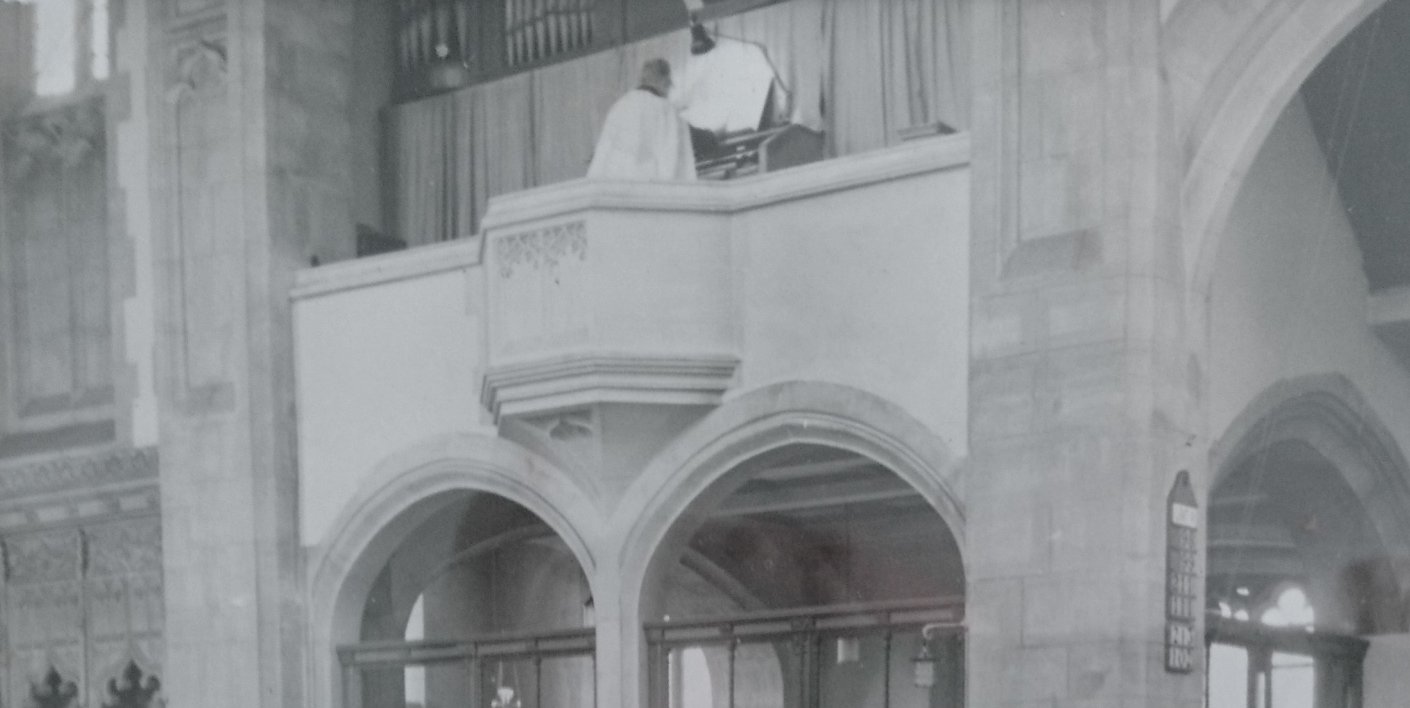 In 1929, a sum of £26. 5. 0. was spent on repairs, these being carried out by Rothwells of Harrow. The only other entry appears in 1932 when attention was called to the position of the Organist's seat and the Finance and General Purposes Committee authorised "such steps as considered necessary". A strange entry indeed and amusingly ambiguous.
In 1929, a sum of £26. 5. 0. was spent on repairs, these being carried out by Rothwells of Harrow. The only other entry appears in 1932 when attention was called to the position of the Organist's seat and the Finance and General Purposes Committee authorised "such steps as considered necessary". A strange entry indeed and amusingly ambiguous.
In June 1946 there was some discussion on the question of providing a new Organ. It was suggested that Bishops be asked to quote for (a) a complete rebuild and (b) a new Organ.
At the same time the John Compton Organ Co. prepared schemes for both two and three manual Organs. These specifications exist in the records and make interesting reading to the Organ enthusiast. The Church Council spent much time discussing these matters and at one point Dr Osborne Peasgood, Sub-organist of Westminster Abbey, was called in to advise, but by March 1947 no decision had been made.
In June 1947, the Vicar, Rev. L.H. Yorke, stated that he had seen an Organ built in 1937 by Kingsgate-Davidson for a private house in Hampstead. It had not been played for 6 years and was for sale at £1800. A further £450 would be required to erect it in the Church. After much consideration a decision was taken to purchase the Instrument. The casework exists to this day, somewhat altered and considerably less pleasing aesthetically. Considering the Organ was neither built nor voiced for the Church, it sounded rather well. There were many most acceptable voices particularly on the Swell, and it is well remembered that the Trumpet added considerable fire to full organ effects. The Pedal organ was, of course, totally inadequate except in use with some of the quieter manual stops. The action was Tubular pneumatic to the manuals and Tracker to the Pedals.
Specification:
| GREAT ORGAN | SWELL ORGAN | PEDAL ORGAN | |||
| Open Diapason I | 8' | Open Diapason | 8' | Bourdon | 16' |
| Open Diapason II | 8' | Salicional | 8' | Bass Flute | 8' |
| Stopped Diapason | 8' | Gedackt | 8' | Dulciana | 8' |
| Wald Flute | 8' | Celeste | 8' | ||
| Dulciana | 8' | Salicet | 4' | ||
| Principal | 4' | Lieblich Flute | 4' | ||
| Harmonic Flute | 4' | Nazard | 22/3' | ||
| Mixture | 12-15 | Tierce | 13/5' | ||
| Trumpet | 8' | ||||
| Oboe | 8' | ||||
| Tremulant | |||||
Couplers:
| Swell Octave | 5 thumb pistons to Swell |
| Swell Sub-Octave | 5 thumb pistons to Great |
| Swell to Great | 1 reversible Great to Pedal |
| Swell to Pedal | 5 toe pistons to Swell |
| Great to Pedal | 5 toe pistons to Great |
In 1953 came the news that the Church was to be completed. For those who were interested in the musical side of life at St Michael's this was an exciting time, for the design of an Organ is a most fascinating subject. Here we were to have a larger, more versatile instrument to suit the requirements of a larger building.
The new instrument would incorporate a great part of the existing Kingsgate-Davidson with suitable additions and a greatly reinforced Pedal department. However, as a large part of the cost was to be met by the Diocesan Authorities, St Michael's did not have a great deal to say when it came to the question of design and in fact very little of the old Organ was used. Much of the material came from the London Organ Pool. This was pipework and action salvaged from bomb damaged city Churches. As time has passed, the inclusion of this old pipework has proved to be of immense interest. The work was undertaken by N.P. Mander and completed in 1956. The specification is as follows, with provision at the Console only for a Great and Pedal Reed unit. The only alteration was some revoicing work to the Great Fifteenth when the Organ was cleaned in 1971.
Specification:
| GREAT ORGAN | SWELL ORGAN | PEDAL ORGAN | |||
| Double Diapason | 16' | Open Diapason | 8' | Open Wood | 16' |
| Open Diapason I | 8' | Stopped Diapason | 8' | Bourdon | 16' |
| Open Diapason II | 8' | Angelica | 8' | Minor Bass | 16' |
| Claribel | 8' | Principal | 4' | Octave | 8' |
| Dulciana | 8' | Mixture II ranks | 12-15 | Flute | 8' |
| Principal | 4' | Double Trumpet | 16' | Fifteenth | 4' |
| Harmonic Flute | 4' | Horn | 8' | Flute | 4' |
| Twelfth | 22/3' | Oboe | 8' | Octavin | 2' |
| Fifteenth | 2' | Double Trumpet | 16' | ||
| Trumpet | 8' | ||||
Couplers:
| Svrell Octave | 5 thumb pistons to Swell |
| Swell Sub Octave | 5 thumb pistons to Great |
| Swell to Great Octave | 1 reversible Great to Pedal |
| Swell to Great | |
| Swell to Great Sub Octave | |
| Swell to Pedal | |
| Great to Pedal |
Every Organ has its failings and the Instrument at St Michael's is no exception. However, it has many times been likened to a fine Cathedral Organ in miniature, and it is certainly true that the sound of full Organ -the rich swell reeds coupled to a bright ringing great chorus -is satisfying. Unfortunately it is not possible to appreciate the Organ to the full because of the enclosed nature of the loft high up on the North side of the Church. It is believed that the original plan, allowing as it would have done for wider and more lofty side aisles, would have permitted an opening from the Organ chamber above the Lady Chapel arch, thus allowing the Instrument to speak down the Church.
A visit to the loft provides a most interesting spectacle with the neat rows of pipes of so many sizes ranging from 16ft in length to just an inch or so, and the many decorated pipes of the Victorian period.
 |
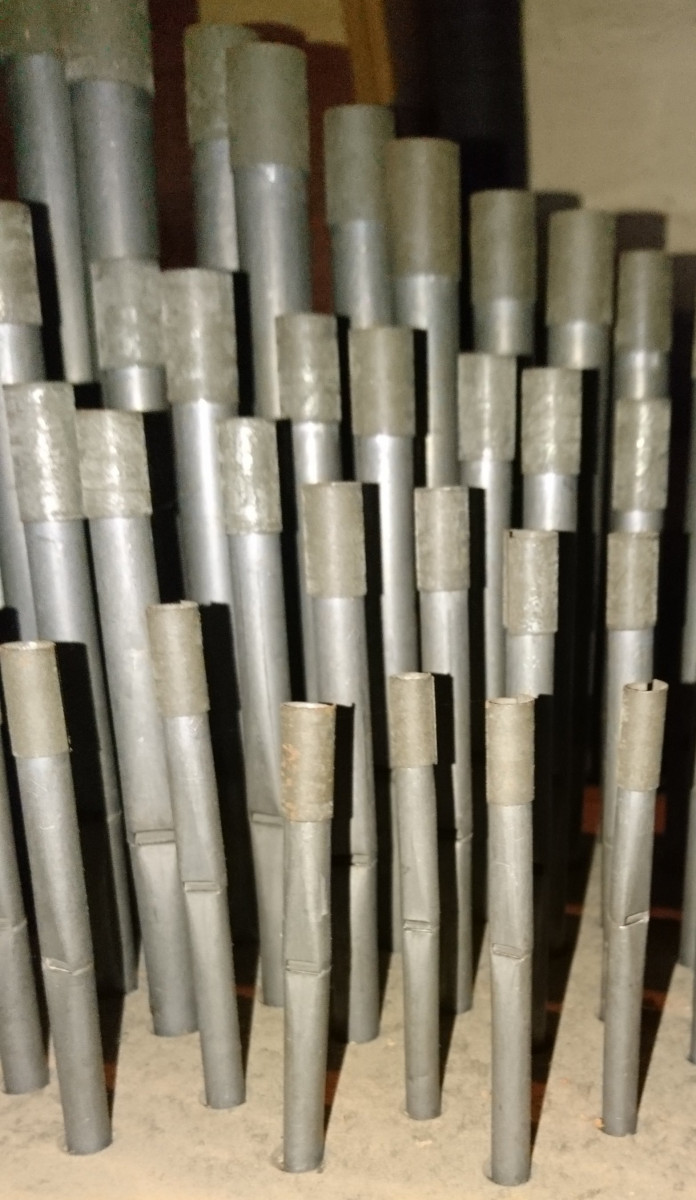 |
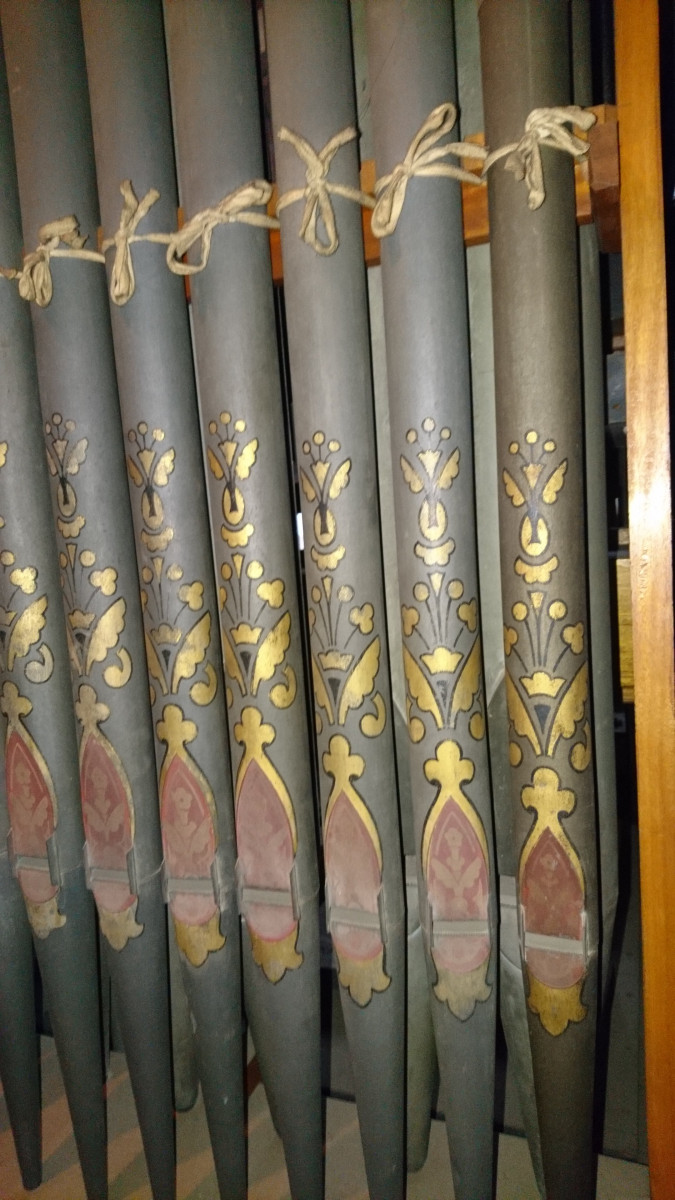 |
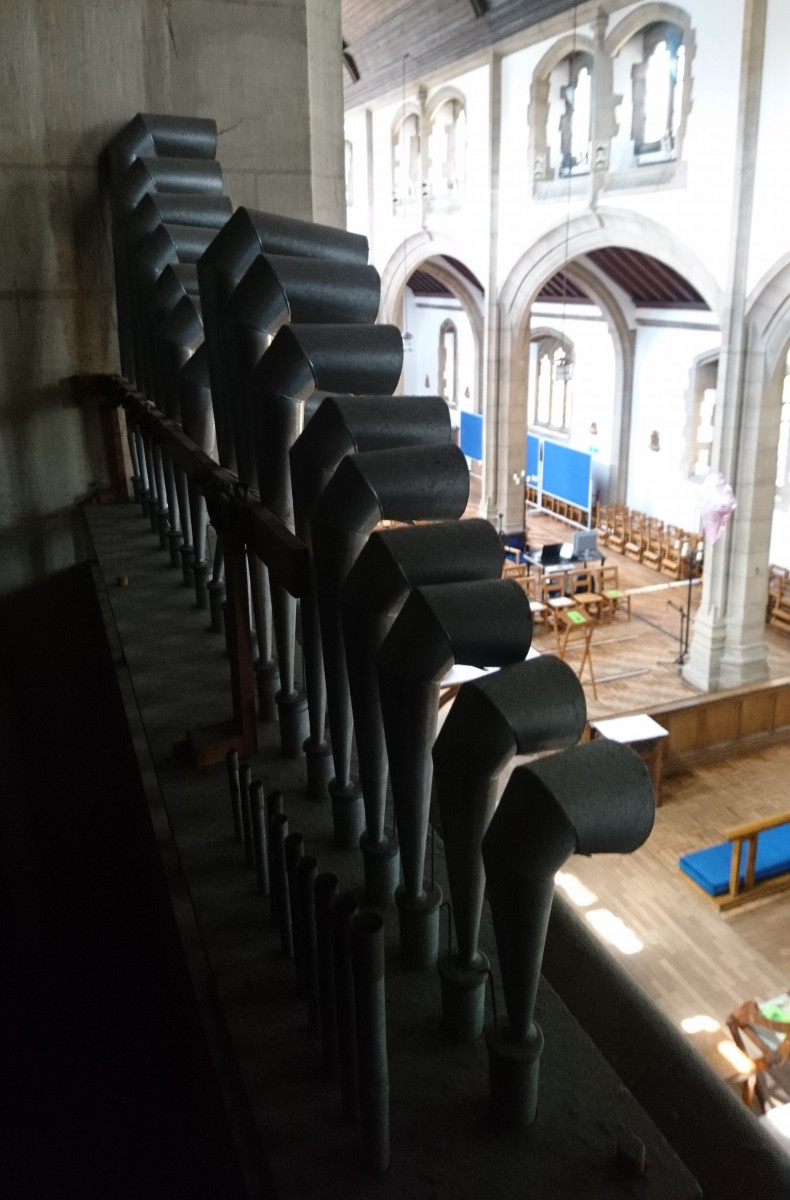 |
It contains work by Bevington, Bryceson, Walker, Lewis and Gray and Davison, all top rate 19th Century organ builders. Some of the work is believed to date from around 1840. Careful revoicing and regulating has satisfactorily brought together the work of these fine craftsmen. One can now begin to appreciate the value of our Organ.
It was always hoped to add the Great and Pedal Reeds, but the cost always appeared too heavy.
Now (1976 at the time of writing), through a lot of effort, determination and enthusiasm, the work is to proceed. There are to be other alterations and the changes can be summarised as follows.
Great Organ:
- To remove the present Dulciana which plays no useful part, and to put in its place the Swell Organ Angelica, suitably revoiced to provide a register of more warmth and fullness of character.
- To add a two rank Mixture (19-22) using as a basis the existing Swell Mixture pipework.
- To add a Posaune 8ft. This to have a free tone to act not only as a solo reed, but to give a brilliant 'top' to the Organ.
Swell Organ:
- To revoice the Open Diapason to provide more fullness of tone.
- To replace the Angelica with a register of more string-like quality.
- To add a new Fifteenth 2ft.
- To add a new Sesquialtera (12-17)
- The Great Posaune to be playable from the Swell manual.
Pedal Organ:
- To add a downward extension of the Great Posaune to provide an independent Ophicliede 16ft., also available at 8ft. pitch.
The final specification (1976):
| GREAT ORGAN | SWELL ORGAN | PEDAL ORGAN | |||
| Double Diapason | 16' | Open Diapason | 8' | Open Wood | 16' |
| Open Diapason I | 8' | Gedackt | 8' | Bourdon | 16' |
| Open Diapason II | 8' | Vox Angeelica | 8' | Minor Bass | 16' |
| Claribel | 8' | Principal | 4' | Octave | 8' |
| Dulciana | 8' | Fifteenth | 2' | Flute | 8' |
| Principal | 4' | Sesquialters | 12-17 | Fifteenth | 4' |
| Harmonic Flute | 4' | Double Trumpet | 16' | Flute | 4' |
| Twelfth | 22/3' | Trumpet | 8' | Octavin | 2' |
| Fifteenth | 2' | Oboe | 8' | Ophicleide | 16' |
| Mixture | 19 22 | Posaune (Gt) | 8' | Double Trumpet | 16' |
| Posaune | 8' | Tremulant | Posaune | 8' | |
| Trumpet | 8' | ||||
Couplers and accessories as before.
These additions and alterations will make for a very complete and exciting tonal scheme and will enhance the Organ's versatility as an Instrument for the accompaniment of the Church
services and for recital work.
THE ORGAN TODAY
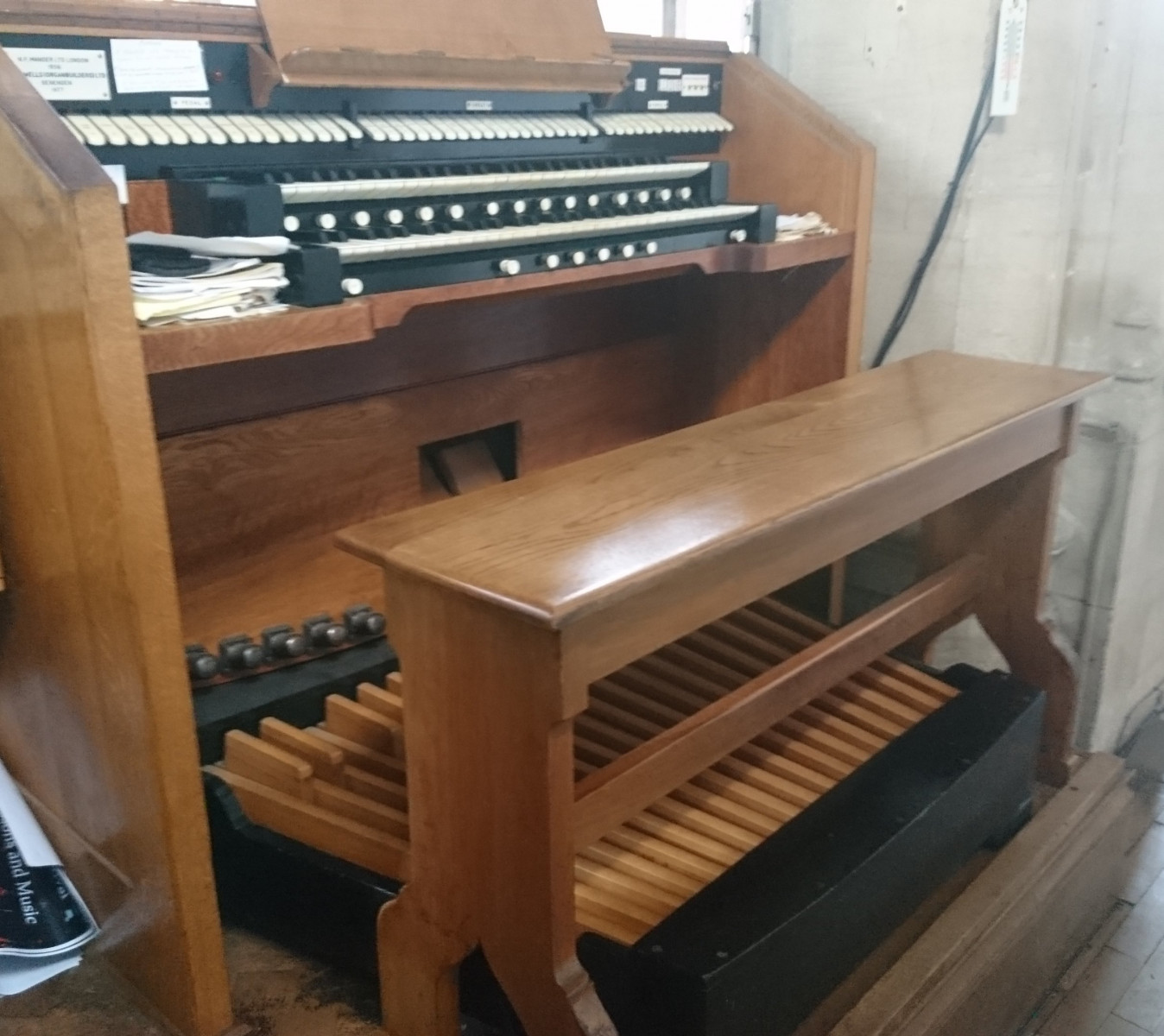 Our present organist writes that since 1977 the organ has been altered again with some stop changes and the addition of ten general pistons and a computerised piston system which enable a number of organists to set up their own personal piston programmes.
Our present organist writes that since 1977 the organ has been altered again with some stop changes and the addition of ten general pistons and a computerised piston system which enable a number of organists to set up their own personal piston programmes.
 The 1977 Great Posaune 8' and Clarion 4', visible at the front with hooded pipes directing the sound across the chancel into the church, are the "crowning glory" of the instrument, perfect for dramatic fanfares or soloing out hymn tunes. When added to the otherwise full organ with the Ophicleide 16', the effect is arresting and thrilling.
The 1977 Great Posaune 8' and Clarion 4', visible at the front with hooded pipes directing the sound across the chancel into the church, are the "crowning glory" of the instrument, perfect for dramatic fanfares or soloing out hymn tunes. When added to the otherwise full organ with the Ophicleide 16', the effect is arresting and thrilling.
The organ as a whole sounds remarkably impressive down the church and more so when the church is empty, when a short reverberation period enhances the sound still further.
SPECIFICATION 2021
| GREAT ORGAN | SWELL ORGAN | PEDAL ORGAN | |||
| Double Diapason | 16' | Stopped Diapason | 8' | Subbass | 32' Acoustic |
| Open Diapason I | 8' | Salicional | 8' | Open Wood | 16' |
| Open Diapason II | 8' | Voix Celeste | 8' TC | Bourdon | 16' |
| Gedackt | 8' | Principal | 4' | Great Bass (Gt) | 16' |
| Dulciana | 8' | Fifteenth | 2' | Octave | 8' ext |
| Principal | 4' | Mixture | 19 22 26 | Bass Flute | 8' ext |
| Nason Flute | 4' | Double Trumpet | 16' ext | Fifteenth | 4' ext |
| Nazard | 22/3' | Trumpet | 8' | Flute | 4' ext |
| Fifteenth | 2' | Clarinet | 8' | Mixture | 19 22 26 29 |
| Mixture | 19 22 | Clarion | 4' ext | Ophicleide | 16' ext |
| Posaune | 8' | Posaune (Gt) | 8' | Double Trumpet (Sw) | 16' |
| Clarion | 4' ext | Tremulant | Posaune | 8' | |
| Swell Sub Octave to Great | Swell Sub Octave | Trumpet (Sw) | 8' | ||
| Swell to Great | Swell Unison Off | Clarion | 4' ext | ||
| Swell Octave to Great | Swell Octave | Clarion (Sw) | 4' | ||
| Swell to Pedal | |||||
| Great to Pedal | |||||
- 5 Pistons to Great, Swell and Pedal
10 General Pistons
Balanced Swell Pedal
Crescendo Pedal
General Cancel Piston
- The Posaune 8' (Gt) on the Swell can also be used as a solo reed and does not couple through to the Great.
- Several stop tabs at the console are "prepared for" only. They are the Blockflute 2', Tierce 13/5', Larigot 11/3' on the Great and the Contra Trombone 32' on the Pedal.
The Great Mixture is labelled IV ranks but is actually II ranks 19th and 22nd.
The Nazard 22/3' stop only functions when the Larigot 11/3' stop is depressed!
- The present specification shown above has remained unaltered for at least the past twenty years.
 A LETTER RECEIVED FROM THE ARCHITECT A LETTER RECEIVED FROM THE ARCHITECT |
ST MICHAEL'S TODAY  |
